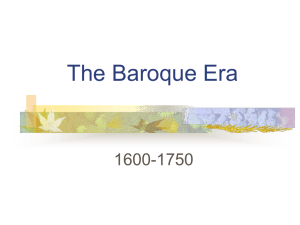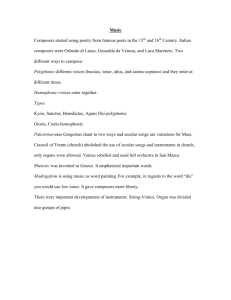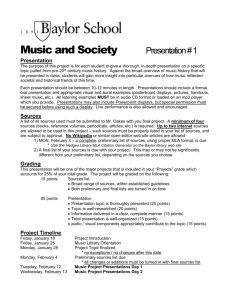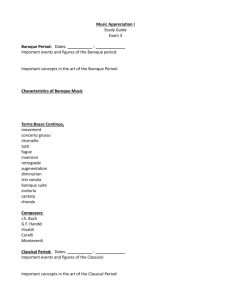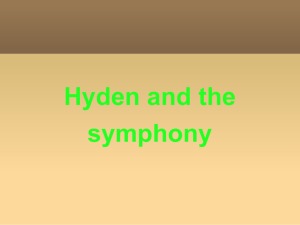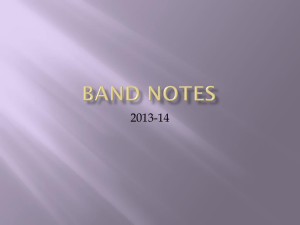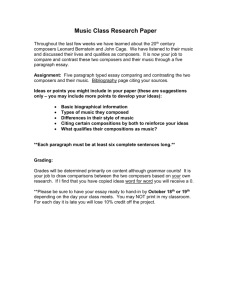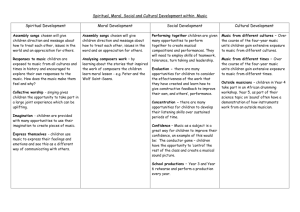Final SP Paper - Ross School Senior Projects
advertisement
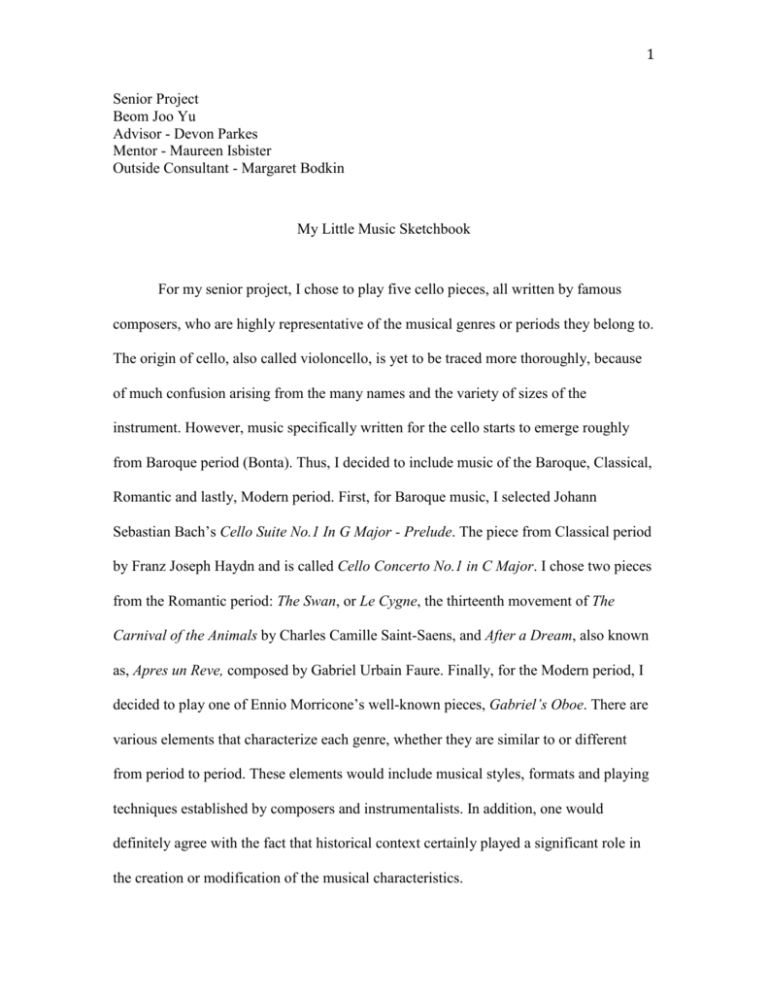
1 Senior Project Beom Joo Yu Advisor - Devon Parkes Mentor - Maureen Isbister Outside Consultant - Margaret Bodkin My Little Music Sketchbook For my senior project, I chose to play five cello pieces, all written by famous composers, who are highly representative of the musical genres or periods they belong to. The origin of cello, also called violoncello, is yet to be traced more thoroughly, because of much confusion arising from the many names and the variety of sizes of the instrument. However, music specifically written for the cello starts to emerge roughly from Baroque period (Bonta). Thus, I decided to include music of the Baroque, Classical, Romantic and lastly, Modern period. First, for Baroque music, I selected Johann Sebastian Bach’s Cello Suite No.1 In G Major - Prelude. The piece from Classical period by Franz Joseph Haydn and is called Cello Concerto No.1 in C Major. I chose two pieces from the Romantic period: The Swan, or Le Cygne, the thirteenth movement of The Carnival of the Animals by Charles Camille Saint-Saens, and After a Dream, also known as, Apres un Reve, composed by Gabriel Urbain Faure. Finally, for the Modern period, I decided to play one of Ennio Morricone’s well-known pieces, Gabriel’s Oboe. There are various elements that characterize each genre, whether they are similar to or different from period to period. These elements would include musical styles, formats and playing techniques established by composers and instrumentalists. In addition, one would definitely agree with the fact that historical context certainly played a significant role in the creation or modification of the musical characteristics. 2 Baroque music refers to music written during the period from 1600 to 1750 (Kozinn). During the Baroque period came an increasing importance of scientific investigation. The period was generally considered the start of the era of experimentation, and scientists broke away from the older form of science. Instead, through observation and experiment, they devised hypotheses about why things happened. In politics, the royal despotism culminated; in Europe at the time, small group of leaders, such as princes and kings, possessed power (Music History). Virtuosity was highly honored in the field of music. Musicians believed in the idea that music could move the listeners in a physical way. In instrumental music, composers experimented with ways of creating impressive effects (Music History). Composers used the word baroque to describe early music that seemed to be distorted by a profusion of unnatural ornamentation (Kozinn). Furthermore, roles of music gradually expanded. For instance, many of new styles began to serve as an adornment to religious services or as a source of entertainment. Composers became aware of distinct styles of national music both in vocal and in instrumental, and thus made use of them in their music. They also created countless instrumental forms and styles, such as madrigal, oratorio, sonata, motet, cantata, Scarlatti, and the concerto. Performers reached new heights of expression and technique. Virtuoso players such as Archangelo Corelli and Antonio Vivaldi reflected these abilities in their own compositions (Music History). Generally, composers used the word ‘baroque’ to describe early music that seemed to be distorted by a profusion of ‘unnaturalness’ (Kozinn). Johann Sebastian Bach was perhaps one of the most beloved composers during the period. He was born in Germany, on March 21, 1685. He had an innate musical 3 talent. As a child, he learned to play the organ and the clavichord and sang in a choir. At the age of fifteen, he was already able to financially support himself by holding some organist positions in nearby towns. He was a master at composing concertos, cantatas, piano inventions and other religious music. For most of his life, he used the organ and clavichord to compose. Among his piano inventions, the F Major and A Minor are very well known. Bach was not introduced to the piano until he was sixty years old. Once he discovered the instrument, he wrote a six-part fugue for King Frederick. Later on in life, Bach was stricken with blindness. He underwent an operation to try to correct the blindness, but it was unsuccessful and only aggravated the condition. As a result, he suffered from a paralytic stroke and eventually died in July 28, 1750 (Great Composers, Bach). The Baroque composers' concept of music was very different from that of the Modern, which is more similar to that of the Classicism. For instance, in the nineteenth century, counterpoint, with its multiple, semi-melodic lines, yields to single melodies involving more chordal arrangement. Also, an overtly emotional element gradually emerged. Baroque music, however, like the Bach Cello Suites, seems less “goal-oriented” than much nineteenth century music (Janof). Bach’s Cello Suites, thought to be written specifically for the cello, have been transcribed into many other instruments, such as the flute, piano, guitar, trumpet, tuba, saxophone, banjo and many more (Siblin, 6). The Suites include six parts. Then, each is again divided into six different movements, most of which have the roots in old European dance (Siblin, 7) .They all start from Prelude and end with Gigue, but each part is different. In order, they are: Prelude, Allemande, Courante, Sarabande, either Minuet, Bourree or Gavotte and Gigue. The German term 4 'durchfuhrung,' the Baroque technique of melodic elaboration, means 'spinning out’. This is a perfect description of the effect that Bach manages in his Cello Suites, because he “draws out a melodic thread more finely, focusing on the progress from one moment to the next until, before the listener realizes it, the melodic thread has spanned the movement from beginning to end“. Nineteenth century melodic development, with its different form of phrases and cadences, is quite foreign to this spinning-out concept. Moreover, modern cellists would need to consider the amount of vibrato they use in Bach. Many would agree that a “dead” hand is undesirable, since a certain “life” would be needed. Therefore, they make a juicy vibrato, especially in the slower movements. For a Baroque musician, however, vibrating every notes would have seemed as silly as trilling every note, or eating cream cheese on everything, whether stew or strawberries (Janof). It is known that Baroque cellists had rarely used vibrato in any music, not to mention Bach’s Cello Suites. During the Classical period, which indicates the timeline generally from 1750 to 1825, several factors differentiated the period from the previous ones and allowed the music to have its own characteristics. The biggest factor was of course, the Industrial Revolution. New developments in the means of production led to wealth. The Enlightenment also played important roles. The world placed a heavy emphasis on the rights of people, and on the ability of humans to shape their own life. Writers, such as Jean Jacques Roussea and Voltaire helped shape these ideals. Aspect in political ideals of republican government is interesting to look at as well. The Enlightenment’s emphasis on the individual led to the expanding roles of individuals in the political field (Music History). 5 Musical context exactly followed the historical context. For example, because people's view of the nature of this world and of their relationship to it slowly changed, the concept of “natural” became an important component in art as well. Improved economic condition brought about greater wealth. As a result, "the pursuit of happiness" was available to a broader class of society. The "unnatural" components of Baroque music were replaced with "natural" ideals of simplicity and balance, which was critical to composers. Some musical styles emerged, involving simpler textures; homophonic textures became the standard and contrapuntal textures were also used. In addition, simpler melodies developed; melodies usually fell into even phrases, such as symmetrical "question and answer" structures. The piano, with its ability to produce dynamics, became one of the most important solo instruments for composers (Music History). Franz Joseph Haydn, an Austrian composer, was one of the most well regarded musicians of the Classical period. As Paul Henry Rang wrote, Haydn was a musician “who opened the classical era,” and who was permitted “to accompany a new world of art from its inception to its flowering.” Haydn was born on March 31, 1732 in Austria. As a young boy, he was an avid musician who would give impromptu concerts at his neighbors’ home. His interest in music attracted Johann Matthias Frankh, his relative, who eventually suggested that Haydn live with him in nearby Hainburg to learn music from him. For three years Frankh trained Haydn very strictly. Later in his life, Haydn recalled that his lessons proved to be an invaluable preparation for him to become a chorister at the age of eight at St. Stephen’s Cathedral in Vienna. At the age of seventeen, he devoted his spare time either practicing the piano sonatas of Carl Philipp Emanuel Bach or composing his own music. In 1759, Haydn created his first symphony; his first 6 symphonies, like his first quartets, were modeled after the Baroque suites and serenades of his predecessors. Wilfrid Mellers described them as “charming, trivial pieces…a gallant simplification of the Baroque style. Before the age of forty, he had already created countless compositions in every medium: operas, masses, symphonies, quartets, concertos, sonatas, and more. By then, he was one of the most well-known and beloved composer throughout Europe. With the support of Austrian prince, and as conductor of an orchestra, he was able to make experiments and observe what made an effect and what weakened it, and was in a position to alter, to improve, to make omissions or additions, and be as bold as he wanted to be (Great Composers, Haydn). Haydn himself once mentioned, “I was cut off from the world, there was no one to confuse or torment me, and I was forced to become original” (Stove). Karl Geiringer once mentioned, “Haydn shows such virtuosity of instrumentation or such delightful, unorthodox treatment of musical forms and contrapuntal devices… The whole nineteenth century, beginning with Beethoven and ending with Brahms, was able to draw rich inspiration from Haydn” (Great Composers, Haydn). In 1797, Haydn created the famous Gott, erhalte Franz, den Kaiser, which was performed in many theaters on the Emperor’s birthday that year. Since then, it has become the Austrian national anthem. Later in his life, he used the melody to create his String Quartet in C Major, op.76, no. 3, also known as the Emperor Quartet. On December 26, 1803, Haydn held his last concert in Vienna, conducting a performance of his The Seven Words of Christ. After 1803, Haydn’s health aggravated, losing most his memory and the ability to speak. Haydn eventually died on May 31, 1809, with his last 7 word, “I commend my soul to my all-merciful Creator” (Great Composers, Haydn). With Haydn, the symphony, quartet, and sonata were reborn, with new thematic dimensions, a dramatic effect, and more varied range of emotion. It is never too much to say that he opened up the classical era, who introduced many a new concept of structural development, who enriched the harmony and color of orchestration, and who brought individuality to the four instruments in quartets (Great Composers, Haydn). His Cello Concerto No.1 in C Major may be a good example that shows these features of his own. Although Haydn had much less interest in the concerto than Mozart or Beethoven, he was the only one, out of the three Viennese classical composers, to write pieces for cello and orchestra (Laki). In his life, Haydn had created two cello concertos: one in C Major and the other in D Major (Great Composers, Haydn). His first cello concerto, in C Major, was thought to be lost for many years; in 1961, however, a Czech musicologist Oldrich Pulkert discovered a set of part in Prague, and since then, it was instantly taken up by many cellists all around the world. Scholars have dated the piece from between 1762 and 1765. It belongs to the period between Baroque and Classical; as a result, the rhythmic pulse and identical repeats of the first movement’s main themes are Baroque features, whereas the new shape of the musical gestures would be Classical. The solo part is very demanding; it involves rapid passagework and requires a player to frequently ascend to the instrument’s higher position. This shows how accomplished the first cellist of Haydn’s orchestra, Joseph Weigl, must have been (Laki). Like in previous periods, music during the Romantic period obtained its features through some of the major historical themes. Again, science took a big role. Clearer understanding of the world and humanity’s place in it changed the way people acted and 8 thought of themselves and society. Charles Darwin’s The Origin of the Species can be a good example of this new attitude. During the era, strong nationalism also rose. For instance, many European countries, especially Italy and Central Europe, struggled to free themselves from foreign control and created a separate national identity. Many other revolutions took place as well (Music History). Some of unique musical components characterized the Romantic period. For example, during this period, artists conceived of nature in a less idealized way than the artists of the Classical period had. Instead of believing their world as a perfect model, people thought of it more as a source of mysterious powers. More and more, music was used for story telling; in their music, composers started to deal with people, things, dramatic situations, and even philosophical ideas. Moreover, stronger highlighting on national and ethnic identity arose. Composers such as Bedrich Smetana and Giuseppe Verdi made images of nationalism and patriotism in their work. Slowly and steadily, the status of musicians changed. Composers no longer relied on income from employment, but rather from the public support. Furthermore, training institutions such as conservatories substituted the old apprentice system of the church and the court. Surprisingly, women found more opportunities, especially as performers; however, they still had limited access to being composers (Music History). A Music critic M. D. Calvocoressi described that Saint-Saens’ music are the “surpassing excellence of his technique… his lucidity, his versatility, his sense of proportion, and the perfection of what he achieved within the limits of his outlook—limits carefully thought out, deliberately adopted, which he never fell short of or overstepped” (Great Composers, Saint-Saens). 9 Saint-Saens was born in Paris on October 9, 1835. Saint-Saens was very musical as a kid. When he was only two, his aunt started to teach him piano, and he finished his first book of exercises in about a month. Only a couple years later, he was able to compose songs and piano pieces. At the age of ten, he already made his debut in Paris, in which he played a Mozart concerto and a movement from Beethoven’s C Minor Piano Concerto. From 1848 to 1853, he attended the Paris Conservatory; there, he won his first prize in an organ competition. In 1853, Charles Gounod praised Saint-Saens that he would surely develop into “a great master,” when his first symphony was introduced in Paris. He became organist at the Church Saint-Merry, where he gained a prominent reputation as one of the best organists in France at that time. During his mid to late thirties, he toured actively as a pianist and conductor. He also taught piano at the Ecole Niedermeyer, influencing such famous French musicians as Faure and Messager. SaintSaens was well rounded. He wrote poetry, plays, and books on philosophy, literature, painting, and the theater. In addition, he was a linguist and also a student of natural history and physics. It is known that he also wrote music that was Algerian, Persian, Breton, Russian, Arabian, Portugese, and Egyptian. He performed his last piano recital and conducted his last concert in 1921. At the age of 86, he died while on vacation in Algiers on December 16, 1921 (Great Composers, Saint-Saens). Saint-Saens had a gift for combining in harmony the music of the late nineteenth century with the styles of an older day, by “imitating classic forms and recreating the style and structure of an earlier century” (Great Composers, Saint-Sanes). His The Swan, or Le Cygne, the thirteenth movement from The Carnival of the Animals, sometimes called the ‘Grand Zoological Fantasy,’ would show such trait in it. It was made in 1886, 10 originally for two pianos, string quintet, flute, clarinet, glockenspiel, xylophone, and strings. It consists of 14 movements, each representing a different animal (Carnaval des animaux, Le). The names are, in order, Royal March of the Lion, Hens and Cocks, Wild Asses, Tortoises, The Elephant, Kangaroos, The Aquarium, Personages with Long Ears, The Cuckoo in the Forest, The Aviary, Pianists, Fossils, The Swan, and Finale. Usually, each of the fourteen movements mimics the sounds animals make or characterize the way they move. This Carnival is a humorous and parodistic work, and yet a great piece of Saint-Saens that contains the harmony of Classicism and Romanticism, in both structural and stylistic manner. During his lifetime, he performed it only twice—once publicly by the Societe de la Trompette and once in a private performance by Franz Liszt, the famous pianist and composer at the time, who was a good friend of Saint-Saens—because he was afraid to hurt his reputation as a serious composer. Out of all the movements, only The Swan was published; it became one of the most beloved works with cellists and audiences, and remained as one of his popular works all time (Plushie). Gabriel Urbain Faure, otherwise known as a pupil of Saint-Saens, is another eminent French composer during the Romantic period. He was born in France, May 12, 1845. As a child, Faure learned to play the organ by himself. To his amazement, the renowned teacher Niedermeyer offered to have the boy musically trained. In 1854, Faure entered the Ecole Niedermeyer in Paris, a school of religious music. At the age of 21, he became the organist of the Sait-Sauveur churce in Brittany. Several years later, he quit it and became the organist at Notre Dame de Clignancourt in Paris. As he became more and more famous, he finally became assistant organist and choirmaster at the Madeleine Church. Soon, Liszt became interested in him and helped him musically. During this 11 period, Faure wrote some of his greatest works: Sonata No. 1 in A Major, for violin and piano, and the Piano Quartet in C Minor. Faure’s the Requiem remains one of the most “poignant, deeply moving works in French choral music…nothing purer, clearer in definition has been written,” noted Nadia Boulanger. Other than composing, Faure also devoted his life in teaching. He taught his composition classes at the Ecole Niedermeyer. One of his pupils Koechlin described his teacher: “This ‘revolutionary’ proved to be a purist as a teacher, to detest clumsiness and carelessness. He himself, and the high standards of his own art, proved in the last resort the most effective spur to his pupils. Faure continued to write music in poetic expressiveness, one of the distinct characteristics of the Romantic period. These include Pelleas et Melisande, written for Maeterlinck’s impressionist, La Chanson d’Eve, L’Horizon Chimerique, and String Quartet in E Minor. During the last four years of his life, he spent time in retirement. His health deteriorated, to the point where he became totally deaf (Composers since 1900). Faure died in Paris November 4, 1924. In his deathbed, he was still thinking about his music. “Have my works received justice?” he inquired. “Have they not been too much admired or sometimes too severely criticized? What of my music will live?” And to these questions he provided his own answer: “But, then, it is of little importance” (Composers since 1900). “Faure’s stylistic development links the end of Romanticism with the second quarter of the twentieth century, and covers a period in which the evolution of musical language was particularly rapid”. It is considered that his music is divided into four styles. After his attempts of Classical manner of Haydn and Mendelssohn, his first style strongly shows the aesthetic language of Romanticism. His second style was matured 12 during the period of Parnassian poets, which best showed his sprightly but melancholy temper. In the 1890s, he developed his third style, in which he put emphasis on bold and forceful expressiveness. In the style of his final period, he “pursued a solitary and confident course, ignoring the attractive innovations of younger composers and beguiling elements of his 1880s style.” The characteristics would include “increasing economy of expression, boldness of harmony and enrichment of polyphony” (Nectoux, Faure). One of Faure’s masterpieces Apres un Reve or, After a Dream, was written in the years of his depression. Originally a poem of Faure’s best friend Bussine, Apres un Reve is a song that best captures the bitter remembrance of the ecstatic dream of his love, after the sudden breaking off of the engagement with Marianne. To give musical expression to the dream images of the poetry, Faure is deliberately ambiguous in both key and rhythm (Terry, 101). Perhaps the popularity of this song comes from its excess of feeling. It has been transcribed to many other versions, in which Pablo Casals’ arrangement for cello may the most famous (Nectoux, 31). Finally, the Modern period refers to the timeline generally from 1900 to present. As the world became ‘modern,’ more distinct historical components arose, capacitating more variety on musical contexts as well. During the Modern period, science progressed indescribably and quickly. We live in a century in which things happen that were unthinkable to earlier generations. We now possess the technological ability to manage almost every aspect of the world. Thanks to modern science, instantaneous global communication was mad possible. We can send and receive messages at an instant, and such advances reshaped entertainment and learning. In political views, the decline of the Russian and Chinese revolutions along with Adolf Hitler of Germany through the 13 movements for freedom and democracy proved the ‘ultimate strength of the human spirit’ (Music History). Similarly, in music, many elements have been either newly established or modified. While some composers kept their distance from the styles and values of the past, others tried to return to the past, especially to the styles of Classicism. The concept of ‘popular music’ emerged, such as jazz, country and rock. With the advent of sound recording, popular music, along with works from all musical periods became easily accessible to the public. This formed a sense of global music culture, in which Western music was dominant. Western musicians have gradually become interested in the music from other cultures, and have accepted the non-Western styles as well. Countless films of greatest value, such as The Good, the Bad, and the Ugly; Once Upon a Time in America; Once Upon a Time in the West; the Mission and the Legend of 1900, were born in the hands of Ennio Morricone, a virtuoso film maker of today. Morricone was born on November 10, 1928 in Italy. At the age of six, he began to write his own music. When he was twelve years old, he entered the Santa Cecilia Conservatory in Rome, and majored in trumpet. There he met his lifelong fellow classmate and later coworker, Sergio Leone. He also studied composition under one of the most prestigious composers in Italy, Goffredo Petrassi. In 1954, he began to compose and arrange music for radio dramas, and a year later, he started to ghostwrite scores for films. That year, he also joined the military, in which he transcribed music by many composers for a military band. In 1960, Morricone now began to write pieces for television shows and films in Italy. Some of his first works include Il Federale, La voglia Matta, Il Successo and the TV series The Virginian. From 1965 to 1969, Morricone worked with Leone on such 14 films as A Fistful of Dollars, The Good, The Bad and The Ugly and Once Upon a Time in the West, wherein they made some of the most memorable tunes in history. By this time, Morricone had attracted many Hollywood directors, and he started to compose score for the famous Clint Eastwood’s film Two Mules for Sister Sara. In 1978, he was nominated his First Oscar for Days of Heaven. Though he did not win the prize, he came to be famous in the United States. Until today, he has gained countless prizes, including the Oscar, British Academy Award Grammy Award, and so forth. Morricone now lives in Rome with his wife, Maria (Moriconne, Ennio). “I don’t believe that I do work hard,” he said. “Think of J. S. Bach, think of W. Mozart and of many others. Their music was their life… I’m not tired of writing music. It’s the only thing I believe I know how to do” (Morricone, Ennio). When he participated in the music arrangement for the film The Mission, he finally positioned himself as one of the most celebrated music directors of the time (Morricone, Ennio). Gabriel’s Oboe is a tune of his, which he used in this film. In it, an Argentinean Catholic missionary is dispatch to villages in Brazilian forest. There, he approaches the natives with his playing oboe. This piece also was introduced through a version of a cello and orchestra, when Morricone and world-renowned cellist Yo-Yo Ma collaborated in 2004. Morricone included various types of instrument in the tune. Starting off placid, the melody blooms into a dramatic and grand climax, adorning the finale with a promising future and a feeling of nostalgia. In this collaboration album is another version written for cello and piano, in which overall impression is much softer, but still expressive and touching. This tune is well known to us as Nella Fantasia, a vocal version sung by Sarah Brightman. 15 Johann Sebastian Bach, Franz Joseph Haydn, Charles Camille Saint-Saens, Gabriel Urbain Faure and Ennio Morricone share some factors in common: they are simply well known virtuoso composers who are representative of their time periods. Bach is considered one of the greatest composers from Baroque period, and also the ‘Father of Music;’ Haydn, a maestro of classical music, sometimes called the ‘Father of the Symphony,’ had created countless masterpieces for many instruments; Saint-Saens and Faure are contemporary composers from the Romantic period, who had left pieces that are still fond of; finally, Morricone is a film music director of modern day, who has also created many familiar tunes. Another common factor is that they are composers who wrote music for the cello, some of them accompanied by either the piano or by an orchestra of various instrumental arrangement. Moreover, in musical view, the periods share many similarities, all partly based on or inspired from each other. On the other hand, the composers and their music differ from each other in terms of their styles, formats and techniques, simply because each of them lived in a different period in history. While the Baroque period sought for ‘unnatural’ in music, Classical put heavy emphasis on ‘natural,’ still keeping its foot on some of the aspects that Baroque contained. During the Romantic period, people started to question the nature as a source of mysterious power, whereas Classicism conceived of it as a perfect model. Finally in Modern music, people gradually became more open to the variety of music and accommodated different kinds of music all over the globe. History and music always have been inseparable elements in life, keeping the relationship of symbiosis. As long as they exist, they shall forever be entangled through the course of life, continuously offering mankind pleasure, sorrow and hope. 16 Works Cited "Bach, Johann Sebastian." Great Composers 1300-1900. 1966. Biography Ref Bank Select. Web. 9 Mar. 2011 Bonta, Stephen. "Violoncello." Grove Music Online. Oxford Music Online. Web. 16 Mar. 2011. "Carnaval des animaux, Le." The Oxford Companion to Music. Ed. Alison Latham. Oxford Music Online. Web. 14 May. 2011. "Faure, Gabriel." Composers since 1900 1st Supplement; Composers since 1900. 1969. Biography Ref Bank Select. Web. 9 Mar. 2011. "Haydn, Joseph." Great Composers 1300-1900. 1966. Biography Ref Bank Select. Web. 9 Mar. 2011. Janof, Tim. "INTERPRETATIONAL ANGST AND THE BACH CELLO SUITES by Tim Janof." INTERNET CELLO SOCIETY. Web. 1 Mar 2011. Kozinn, Allan. "Baroque Music." Grolier Multimedia Encyclopedia. 2011. Web. 10 Mar. 2011. Laki, Paul. “Cello Concerto No. 1 in C major.” The Kennedy Center. Web. 1 Mar. 2011. "Morricone, Ennio." Current Biography. 2000. Biography Ref Bank Select. Web. 14 May 2011. “Music History.” Oracle Education Foundation. 2010. Web. 1 Jan. 2011. Nectoux, Jean-Michel, and Roger Nichols. Gabriel Faure: a Musical Life. Cambridge: Cambridge UP, 2004. Print. Nectoux, Jean-Michel. "Fauré, Gabriel." Grove Music Online. Oxford Music Online. Web. 14 May. 2011. Plushie, Nick. “Review of Carnival of the Animals.” The Pride Lands Online. 13 Dec. 1996. Web. 14 May. 2011. "Saint-Saens, Camille." Great Composers 1300-1900. 1966. Biography Ref Bank Select. Web. 9 Mar. 2011. Siblin, Eric. The Cello Suites: J.S. Bach, Pablo Casals, and the Search for a Baroque Masterpiece. New York: Grove, 2011. Print. Stove, R. J. A Student's Guide to Music History. Wilmington, DE: ISI, 2008. Print. 17 Terry, Paul, David Bowman, Lucien Jenkins, and Monica Leiher. A Student's Guide to AS Music: for the Edexcel Specification 2001-2004. London: Rhinegold Pub., 2001. Print.

